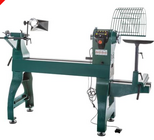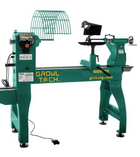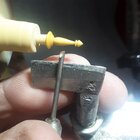I know that Nova has a direct drive lathe, and I think it is also fully digitally controlled. With the troubled Teknatool is having in the US, I've wondered about its longevity. From what I have heard its an excellent lathe and the direct drive is very nice (as direct drive things tend to be!)
I received an email about another digital direct drive lathe today. From Grizzly. I don't know how to rank Grizzly in terms of overall quality, but, it is interesting that it is a digital direct drive lathe with three horsies of power as well:

 www.grizzly.com
www.grizzly.com
The whole package deal is pretty interesting, given all the features it has. From what I can tell, it has a swing-away tailstock bed, more akin to the Robust than most other swing-aways (looks like it rotates out of the way, rather than actually swings.) It has an outboard bed, that can be used not only on the opposite side of the heastock, but one of the photos showed it attached to the FRONT of the bed, allowing the tailstock to be moved farther out...I guess for really LARGE diameter turnings? For outboard turning at the headstock, it looks like it has some kind of tool rest extender. Also includes a chuck guard and a dust collection hood that attaches to the tailstock on an adjustment rod.
Feature wise, I haven't even seen some of these. For the price, less than four grand right now, its got a heck of a lot of premium-level features.
Don't know about materials, and how well the lathe handles things like dampening vibration and all of that. Don't know if anyone uses Grizzly much, or if anyone reviews them. Would be interesting to hear how it really performs and whether there are things like vibration problems, or not.
Anyway, interesting lathe, with some interesting features.
I received an email about another digital direct drive lathe today. From Grizzly. I don't know how to rank Grizzly in terms of overall quality, but, it is interesting that it is a digital direct drive lathe with three horsies of power as well:

24-1/2" Heavy-Duty Wood Lathe - Grizzly Industrial, Inc.
<h1>G0995 24-1/2" Growl-Tech™ Heavy-Duty Wood Lathe</h1><h2>Upgrade your woodturning with advanced digital controls and a switch reluctance motor for smooth and consistent power.</h2><p>Revolutionize your woodturning with increased capacity, smooth and consistent power, and advanced digital...
The whole package deal is pretty interesting, given all the features it has. From what I can tell, it has a swing-away tailstock bed, more akin to the Robust than most other swing-aways (looks like it rotates out of the way, rather than actually swings.) It has an outboard bed, that can be used not only on the opposite side of the heastock, but one of the photos showed it attached to the FRONT of the bed, allowing the tailstock to be moved farther out...I guess for really LARGE diameter turnings? For outboard turning at the headstock, it looks like it has some kind of tool rest extender. Also includes a chuck guard and a dust collection hood that attaches to the tailstock on an adjustment rod.
Feature wise, I haven't even seen some of these. For the price, less than four grand right now, its got a heck of a lot of premium-level features.
Don't know about materials, and how well the lathe handles things like dampening vibration and all of that. Don't know if anyone uses Grizzly much, or if anyone reviews them. Would be interesting to hear how it really performs and whether there are things like vibration problems, or not.
Anyway, interesting lathe, with some interesting features.




